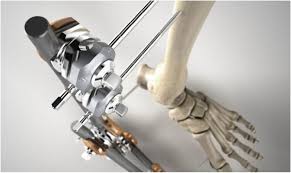Trauma Fixation Device Market Analysis
The Global Trauma Fixation Device Market is poised for robust growth, with a projected increase from US$ 8.13 billion in 2023 to US$ 13.95 billion by 2032, registering a CAGR of 6.18% from 2024 to 2032. This growth is driven by advancements in trauma fixation technology, the rising incidence of traumatic injuries, the expanding aging population, increased surgical interventions, and the growing number of sports-related injuries.
Request a free sample copy of the report: https://www.renub.com/worldwide-trauma-fixation-device-market-and-forecast-519-p.php
Market Overview
Trauma fixation devices are medical tools used to stabilize fractures and other injuries caused by trauma. These devices are typically used for treating bone fractures and joint dislocations and include plates, screws, pins, and rods designed to stabilize the injured area during the healing process. Trauma fixation devices are used in a wide range of treatments, from fractures in the upper and lower extremities (such as the arms, legs, knees, and joints) to complex spinal fractures.
Recent advancements in materials such as high-performance polymers and bioresorbable implants are leading to more durable, efficient, and minimally invasive trauma fixation solutions. These innovations are making trauma fixation devices more accessible and beneficial, improving patient outcomes by enhancing recovery times and reducing complications. The growing shift toward biocompatible materials and drug-eluting implants is revolutionizing the market and driving technological advancements.
Key Growth Drivers in the Trauma Fixation Device Market
- Aging Population
The world’s aging population is a major factor driving demand for trauma fixation devices. Older adults are more prone to osteoporosis, fractures, and degenerative bone diseases, making them more likely to require trauma fixation interventions. According to the UN, the number of individuals over the age of 65 is expected to reach 1.5 billion by 2050, up from 703 million in 2019. This demographic shift is increasing the demand for bone and joint repair treatments, which will, in turn, drive the need for trauma fixation devices.
- Rising Traffic Accidents and Trauma Incidents
The growing number of road traffic accidents worldwide is contributing to a surge in demand for trauma fixation devices. The World Health Organization (WHO) reports that around 1.35 million people die in traffic accidents each year, with millions more suffering non-fatal injuries. The need for fracture stabilization devices is rising as trauma care becomes more critical in emergency medical settings. These devices are crucial for stabilizing injuries in patients who suffer from car accidents, falls, and other traumatic events.
- Increase in Sports Injuries
The rising participation in sports, particularly contact sports such as football, rugby, and basketball, is contributing to an increase in sports-related injuries. Trauma fixation devices play a vital role in stabilizing fractures caused by such injuries. As the awareness and popularity of fitness and sports activities grow globally, the demand for these devices is expected to increase.
- Technological Advancements
Ongoing improvements in trauma fixation device technologies are another key driver of market growth. The use of biocompatible materials, such as polymeric plates, screws, and pins, is helping improve the mechanical properties of fixation devices. Drug-eluting implants, which release medication to prevent infection and promote healing, and nanocoated devices that enhance biocompatibility, are gaining popularity in the trauma fixation market. Robotic-assisted surgeries and advanced imaging systems are also making procedures more precise, reducing recovery times, and improving patient outcomes.
- Government Initiatives and Rising Healthcare Investments
Governments around the world are increasingly funding healthcare programs and initiatives focused on improving access to trauma care, especially in developing regions. Government policies, such as reimbursement programs and incentives for medical technology innovation, are expected to drive market growth. Furthermore, increased healthcare expenditures, particularly in emerging economies, will lead to greater accessibility and availability of advanced trauma care solutions.
Regional Market Insights: North America
North America holds a dominant position in the trauma fixation device market, driven by a combination of factors such as high healthcare expenditure, well-established healthcare infrastructure, and a high incidence of traffic accidents. In the United States alone, there are over 37,000 traffic-related deaths and 2.35 million injuries annually, according to the Association for Safe International Road Travel. This high rate of trauma incidents necessitates the use of trauma fixation devices.
Additionally, the high prevalence of degenerative bone diseases, such as osteoarthritis and rheumatoid arthritis, especially among the elderly population, further contributes to the demand for trauma fixation solutions. According to the Centers for Disease Control and Prevention (CDC), nearly 50% of Americans aged 65 and older are affected by degenerative bone diseases, and this figure is expected to rise to 78 million by 2040.
The presence of key market players in the region, along with advanced surgical centers and rehabilitation facilities, further bolsters the growth of the trauma fixation device market in North America. Furthermore, well-established reimbursement policies and insurance coverage are likely to continue supporting the market’s expansion.
Market Challenges and Opportunities
While the trauma fixation device market is growing, there are several challenges that could potentially hinder growth:
- High Surgical Costs: The cost of trauma fixation procedures and implants can be high, particularly for advanced or customized devices. However, the increasing disposable income in emerging markets and healthcare reimbursement policies may help mitigate this issue.
- Device Complications: While trauma fixation devices are generally safe, complications such as implant rejection or infection can sometimes occur, especially with bioresorbable or metal-based devices. Ongoing improvements in materials and coatings are helping address these concerns.
On the flip side, the development of minimally invasive surgical techniques and personalized trauma care offer significant opportunities for market players. Artificial intelligence (AI) and robotics in trauma surgery are also opening new doors for efficient and precise treatment, improving patient recovery times and outcomes.
Key Companies in the Trauma Fixation Device Market
Some of the leading companies operating in the trauma fixation device market include:
- Zimmer Biomet
- Orthofix Medical Inc.
- B. Braun Melsungen AG
- Stryker Corporation
- Medtronic
- Smith & Nephew
- Integra LifeSciences
These companies are focusing on innovation, product development, and strategic partnerships to strengthen their market position. Collaborations with hospitals and surgical centers, along with a growing portfolio of minimally invasive and biocompatible devices, are key strategies for capturing a larger share of the market.
Recent Industry Developments
- DePuy Synthes (Johnson & Johnson) showcased next-generation trauma fixation solutions at the American Academy of Orthopaedic Surgeons (AAOS) conference in 2021. The innovations included advanced imaging, robotics, and connected instrumentation, aiming to set new standards for trauma care.
- Zimmer Biomet launched Bactiguard-coated trauma implants in the Europe, Middle East, and Africa (EMEA) regions, designed to reduce infection rates in trauma surgeries. These implants received CE certification in early 2021, expanding the company’s reach in global markets.
- Endeavor Orthopedics received 510k FDA approval for its Summit Patella Plating System in 2021, designed for patella fractures stabilization. This approval highlights the company’s focus on expanding its trauma fixation portfolio.
- Zimmer Biomet also announced the spinoff of its dental and spine businesses into a separate entity, allowing it to focus more on its trauma fixation and orthopedic products, potentially accelerating growth in this area.
- FDA Approval: In 2021, the FDA approved ExtremiLOCK Lateral Ankle Fusion Plates, which are designed to repair fractures, non-unions, and osteotomies. This approval allows for faster recovery in ankle trauma cases and adds a new dimension to the trauma fixation device market.
Related Report :
Peripheral Vascular Devices Market
Global Self-Monitoring Blood Glucose Device Market
About the Company:
Renub Research is a Market Research and Consulting Company. We have more than 15 years of experience especially in international Business-to-Business Researches, Surveys and Consulting. We provide a wide range of business research solutions that helps companies in making better business decisions. We partner with clients in all sectors and regions to identify their highest-value opportunities, address their most critical challenges, and transform their businesses. Our wide clientele comprises major players in Healthcare, Travel and Tourism, Food Beverages, Power Energy, Information Technology, Telecom Internet, Chemical, Logistics Automotive, Consumer Goods Retail, Building, and Construction, Agriculture. Our core team is comprised of experienced people holding graduate, postgraduate, and Ph.D. degrees in Finance, Marketing, Human Resource, Bio-Technology, Medicine, Information Technology, Environmental Science, and many more.
Media Contact:
Company Name: Renub Research
Contact Person: Rajat Gupta, Marketing Manager
Phone No: +91-120-421-9822 (IND) | +1-478-202-3244 (USA)
Email: mailto:rajat@renub.com



